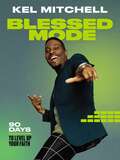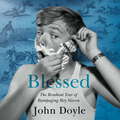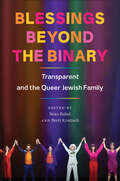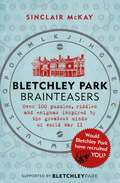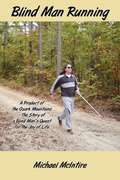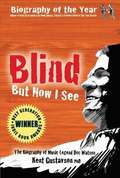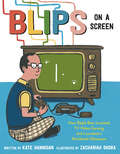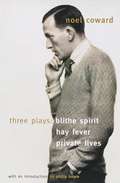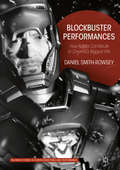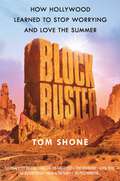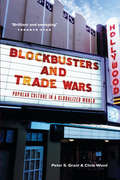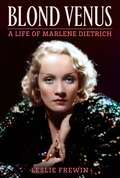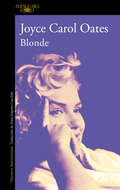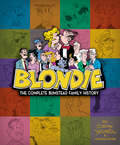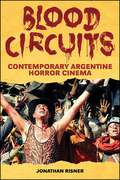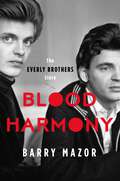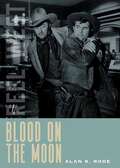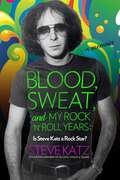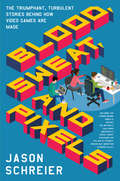- Table View
- List View
Blessed Mode: 90 Days to Level Up Your Faith (A 90-Day Devotional)
by Kel MitchellNo matter what you're going through, one thing is certain: God is ready to bless you. Join Kel Mitchell--pastor, actor, and famed comedian of Kenan & Kel--on a 90-day challenge to receive God's blessings and become a blessing to others.Kel knows what it's like to struggle through depression and addiction, but he also knows the power of God's presence to help you find freedom and the blessings in your life. As a youth pastor, Kel is passionate about sharing his testimony of hope with the next generation, and he wants to share it with you too.In Blessed Mode, Kel offers 90 powerful, practical devotions to help you:find freedom in God's life-changing presence.experience God's power through prayer.recognize God's many gifts in your life.share the blessings you've received with others. Get ready to level up your faith and celebrate the blessings God is giving you today.
Blessed: The Breakout Year of Rampaging Roy Slaven
by John DoyleWho is Rampaging Roy Slaven? An Australian icon, a raconteur, an athlete of unsurpassable - and some may say improbable - sporting feats. Whether it was riding Rooting King to another Melbourne Cup victory, commentating the Olympics or hobnobbing with the country's upper crust, Rampaging Roy Slaven has lived an extraordinary life.But even some of the greatest men come from humble beginnings. Before he shot to fame as Australia's most talented sportsman, he was just another kid in Lithgow, trying to avoid Brother Connell's strap and garner the attention of Susan Morgan from the local Catholic girls school.Blessed follows one year in the life of the boy who would become Rampaging Roy Slaven, a boy who, even at the age of fifteen, knew he was destined for greatness but had to get through high school first.
Blessed: The Breakout Year of Rampaging Roy Slaven
by John DoyleWho is Rampaging Roy Slaven? An Australian icon, a raconteur, an athlete of unsurpassable - and some may say improbable - sporting feats. Whether it was riding Rooting King to another Melbourne Cup victory, commentating the Olympics or hobnobbing with the country's upper crust, Rampaging Roy Slaven has lived an extraordinary life.But even some of the greatest men come from humble beginnings. Before he shot to fame as Australia's most talented sportsman, he was just another kid in Lithgow, trying to avoid Brother Connell's strap and garner the attention of Susan Morgan from the local Catholic girls school.Blessed follows one year in the life of the boy who would become Rampaging Roy Slaven, a boy who, even at the age of fifteen, knew he was destined for greatness but had to get through high school first.John Doyle, the man who knows him best, delves into the early years of the master of midfield mayhem.
Blessings Beyond the Binary: Transparent and the Queer Jewish Family
by Kathryn Lofton Josh Lambert Jarrod Tanny Shaul Magid Jodi Eichler-Levine Martin Shuster Sarah Bunin Benor Ranen Omer-Sherman Jennifer Glaser Shari Rabin Marilyn Reizbaum Warren Hoffman Joshua Falek Kerstin SteitzTransparent made history as the first television show to feature a transgender character in the main role, as the first streaming series to win the Golden Globe for Best Television Series, and as, in the words of journalist Debra Nussbaum Cohen, “the Jewiest show ever.” No television show in history has depicted the lives of American Jews with as much attention to Jewish rituals, quirks, or culture. And no series has portrayed issues of gender and sexuality alongside Judaism with such nuance and depth, making Transparent a landmark series in the history of television. Blessings beyond the Binary brings together leading scholars to analyze and offer commentary on what scholar Josh Lambert calls “the most important work of Jewish culture of the century so far.” The book explores the show’s depiction of Jewish life, religion, and history, as well as Transparent’s scandals and criticisms and how it fits into and diverges from today’s transgender and queer politics. The first book to focus on Transparent, Blessings beyond the Binary offers a rich analysis of the groundbreaking series and its connections to contemporary queer, trans, and Jewish life.
Bletchley Park Brainteasers: The biggest selling quiz book of 2017
by Sinclair McKayBletchley Park Brainteasers was the runaway Christmas bestseller in 2017 and delighted hundreds of thousands of devoted puzzlers with its fiendish puzzles, riddles and enigmas. It's never to late to join the code breakers of Bletchley Park in their enjoyment of a devilish challenge!Would you love to master morse code? Could you have have outsmarted an enigma machine? Would your love of chess have seen you recruited into the history books?When scouring the land for top-level code breakers, the Bletchley Park recruiters left no stone unturned. As well as approaching the country's finest mathematicians, they cast their nets much wider, interviewing sixth-form music students who could read orchestral scores, chess masters, poets, linguists, hieroglyphics experts and high society debutantes fresh from finishing school. To assess these individuals they devised various ingenious mind-twisters - hidden codes, cryptic crosswords, secret languages, complex riddles - and it is puzzles such as these, together with the fascinating recruitment stories that surround them, that make up the backbone of this book. The code breakers of Bletchley Park were united in their love of a good puzzle. If you feel the same, why not dive in, put your mental agility to the test and discover: Would Bletchley Park have recruited YOU?
Bletchley Park Brainteasers: The biggest selling quiz book of 2017
by Sinclair McKayBletchley Park Brainteasers was the runaway Christmas bestseller in 2017 and delighted hundreds of thousands of devoted puzzlers with its fiendish puzzles, riddles and enigmas. It's never to late to join the code breakers of Bletchley Park in their enjoyment of a devilish challenge!Would you love to master morse code? Could you have have outsmarted an enigma machine? Would your love of chess have seen you recruited into the history books?When scouring the land for top-level code breakers, the Bletchley Park recruiters left no stone unturned. As well as approaching the country's finest mathematicians, they cast their nets much wider, interviewing sixth-form music students who could read orchestral scores, chess masters, poets, linguists, hieroglyphics experts and high society debutantes fresh from finishing school. To assess these individuals they devised various ingenious mind-twisters - hidden codes, cryptic crosswords, secret languages, complex riddles - and it is puzzles such as these, together with the fascinating recruitment stories that surround them, that make up the backbone of this book. The code breakers of Bletchley Park were united in their love of a good puzzle. If you feel the same, why not dive in, put your mental agility to the test and discover: Would Bletchley Park have recruited YOU?
Blind Man Running: A Product of the Ozark Mountains - The Story of a Blind Man's Quest for the Joy of Life
by Michael McintireAutobiography of a blind man's journey through life as a traveling musician
Blind but Now I See: The Biography of Music Legend Doc Watson
by Kent Gustavson<P>From the day Doc Watson stepped off the bus in New York City, the North Carolina music legend changed the world forever. His influence has been recognised by presidents and by the heroes of modern music. This is the first comprehensive biography of Doc Watson, with never before released details about the American guitar icons life. <P>This book includes new interviews with popular musicians: Ben Harper, Michelle Shocked, Warren Haynes, Sam Bush, Bela Fleck, Tom Paxton, Maria Muldaur, John Cohen, Mike Seeger, Peggy Seeger, Abigail Washburn, Ketch Secor, Marty Stuart, Norman Blake, Tony Rice, Pat Donohue, Peter Rowan, Si Kahn, Tommy Emmanuel, Tony Trischka, Greg Brown, Guy Clark, Don Rigsby, David Grisman, Alice Gerrard, Alan O Bryant, Edgar Meyer, Guy Davis, Jack Lawrence, Tao Rodriguez-Seeger, Jean Ritchie, Jerry Douglas, Jonathan Byrd, Larry Long, Paddy Moloney, and many more. . .
Blips on a Screen: How Ralph Baer Invented TV Video Gaming and Launched a Worldwide Obsession
by Kate HanniganAn engaging picture book biography based on the incredible true story of a Jewish refugee who pioneered home video games and launched a worldwide obsession.Do you ever wonder how video gaming was invented? What came before your PlayStation or Xbox? This is the story of Ralph Baer, a refugee from Nazi Germany, who used his skills--and a lot of ingenuity and persistence--to make life a little more fun. Television was new when Ralph returned from serving in World War II, but he didn't settle for watching TV. He knew it could be even more fun if you could play with it. He tinkered and tested, got help and rejected, but with perseverance and skill, he made his vision come true! This is the inspiring story of a fearless inventor who made TV video games a reality.
Blithe Spirit, Hay Fever, Private Lives: Three Plays
by Noël CowardA collection of Cowards' most memorable work. These plays, Blithe Spirit, Private lives and Hay Fever, bring out stories of a novelist, a divorced couple and of a person who visits an eccentric family respectively.
Blockbuster History in the New Russia
by Stephen M. NorrisSeeking to rebuild the Russian film industry after its post-Soviet collapse, directors and producers sparked a revival of nationalist and patriotic sentiment by applying Hollywood techniques to themes drawn from Russian history. Unsettled by the government's move toward market capitalism, Russians embraced these historical blockbusters, packing the American-style multiplexes that sprouted across the country. Stephen M. Norris examines the connections among cinema, politics, economics, history, and patriotism in the creation of "blockbuster history"--the adaptation of an American cinematic style to Russian historical epics.
Blockbuster Performances: How Actors Contribute to Cinema’s Biggest Hits (Palgrave Studies in Screen Industries and Performance)
by Daniel Smith-RowseyThis book examines performances in the American film industry’s highest-earning and most influential films. Countering decades of discourse and the conventional notion that special effects are the real stars of Hollywood blockbusters, this book finds that the acting performances in these big-budget action movies are actually better, and more genre-appropriate, than reputed. It argues that while blockbusters are often edited for speed, thrills, and simplicity, and performances are sometimes tailored to this style, most major productions feature more scenes of stage-like acting than hyper-kinetic action. Knowing this, producers of the world’s highest-budgeted motion pictures usually cast strong or generically appropriate actors. With chapters offering unique readings of some of cinema’s biggest hits, such as The Dark Knight, Pirates of the Caribbean, Star Wars, Iron Man and The Hunger Games, this unprecedented study sheds new light on the importance of performance in the Hollywood blockbuster.
Blockbuster: How Hollywood Learned to Stop Worrying and Love the Summer
by Tom ShoneIt's a typical summer Friday night and the smell of popcorn is in the air. Throngs of fans jam into air-conditioned multiplexes to escape for two hours in the dark, blissfully lost in Hollywood's latest glittery confection complete with megawatt celebrities, awesome special effects, and enormous marketing budgets. The world is in love with the blockbuster movie, and these cinematic behemoths have risen to dominate the film industry, breaking box office records every weekend. With the passion and wit of a true movie buff and the insight of an internationally renowned critic, Tom Shone is the first to make sense of this phenomenon by taking readers through the decades that have shaped the modern blockbuster and forever transformed the face of Hollywood. The moment the shark fin broke the water in 1975, a new monster was born. Fast, visceral, and devouring all in its path, the blockbuster had arrived. In just a few weeks Jaws earned more than $100 million in ticket sales, an unprecedented feat that heralded a new era in film. Soon, blockbuster auteurs such as Steven Spielberg, George Lucas, and James Cameron would revive the flagging fortunes of the studios and lure audiences back into theaters with the promise of thrills, plenty of action, and an escape from art house pretension. But somewhere along the line, the beast they awakened took on a life of its own, and by the 1990s production budgets had escalated as quickly as profits. Hollywood entered a topsy-turvy world ruled by marketing and merchandising mavens, in which flops like Godzilla made money and hits had to break records just to break even. The blockbuster changed from a major event that took place a few times a year into something that audiences have come to expect weekly, piling into the backs of one another in an annual demolition derby that has left even Hollywood aghast. Tom Shone has interviewed all the key participants -- from cinematic visionaries like Spielberg and Lucas and the executives who greenlight these spectacles down to the effects wizards who detonated the Death Star and blew up the White House -- in order to reveal the ways in which blockbusters have transformed how Hollywood makes movies and how we watch them. As entertaining as the films it chronicles, Blockbuster is a must-read for any fan who delights in the magic of the movies.
Blockbusters and Trade Wars
by Chris Wood Peter S. GrantThe unparalleled global distribution of books, television programs and other cultural products would seem to augur well for the diversity of ideas and creative expression. Yet ever more of this flow is concentrated in the hands of fewer giant corporations, significantly American controlled, whose agenda is not pluralism but profit. This book focuses upon the market dynamics that drive ever-greater audiences to "blockbuster" films, TV programs, books and recording artists-at the expense of independent, alternative and increasingly necessary national voices.This is the first book from a Canadian perspective to investigate the facts about where and how cultural artifacts are created, why they are so different from other manufactured products, and why they must be treated differently. Grant and Wood examine how much the nature and size of a cultural industry's owner(s) matters; what "national" really means; how content quotas, expenditure rules and government subsidies help and hinder cultural industries; and why a new international vision must prevail. At the same time, they take a look at competition law and how it can promote diversity while examining how freedom of expression and cultural diversity are inextricably linked.Clearly written, impeccably researched, and passionately argued.
Blond Venus: A Life of Marlene Dietrich
by Leslie FrewinBlond Venus, first published in 1956, is a look at the life and work of German-American screen legend Marlene Dietrich (1901-1992). From Dietrich’s childhood in Berlin to her success in Europe and Hollywood, Blond Venus portrays largely the public life and career of Dietrich; her private life was carefully guarded, and although described in the book, would require later biographies to paint a fuller picture (including the biography prepared by her daughter, Maria Riva). Included are 23 pages of photographs and a screen discography through 1952.
Blonde: A Novel (Ldp Litterature Ser.)
by Joyce Carol Oates«Oates sabe que ya has visto a Marilyn Monroe. La reconocerías en cualquier parte. Tantas imágenes, tantas historias que ya han echado raíces en tu mente. Pero su fuerza y su talento consiste en limitarse a señalar los detalles y traerla de vuelta a la vida, a ella y a todo el siglo: la muchacha desnuda, el terciopelo rojo, las plantas de sus pies.»Bethany Schneider, Newsday «Socorro, siento que la Vida se acerca.» Marilyn Monroe era puro fuego, sexualidad a flor de piel, romances turbulentos; pero también era frágil, una mujer asustada y repleta de inseguridades que buscaba en otros -el Ex Deportista, el Dramaturgo o el Presidente- ese amor que ella misma se negaba. Una artista emblemática cargada de conflictos y temores, de pasiones desatadas; una niña que no dejó de huir hacia delante, y llegó a burlar a la propia muerte para convertirse en leyenda. Tras una exhaustiva documentación, Joyce Carol Oates redibuja la vida interior de Norma Jeane Baker -la pequeña sin padre, la mujer dependiente de tranquilizantes y estimulantes, la malograda actriz y amante- y a su «Amiga Mágica del Espejo», la idolatrada rubia que el mundo llegó a conocer como Marilyn Monroe. ** Premio Ja! Bilbao por el «modernísimo humor negro» de su obra. La crítica ha dicho...«Dramática, provocativa e inquietantemente sugerente, Blonde es tan explosiva como su protagonista, la legendaria Marilyn Monroe. En una prosa impresionista de elevada potencia, Oates crea un retrato sorprendente y conmovedor de la estrella mítica y de la sociedad que la creó y le falló.»Publishers Weekly «Oates nos hace vivir la vida de Marilyn Monroe. Y es un verdadero infierno. Y es brillante. Porque nos querremos arrancar los ojos para dejar de mirar, y es imposible.»Ann Patchett, The Times «Oates rebosa testosterona, y su último libro es agresivo y atrevido. Quiere que miremos a un personaje mítico con nuevos ojos, pero no con los de la cámara, sino con nuestros ojos más humanos.»Philip Weiss, New York Observer «En lo referente a Marilyn Monroe, el público siempre se quedaba en el exterior y miraba hacia el interior, pero he aquí que en esta nueva y apasionante novela, Blonde, Joyce Carol Oates revierte ese proceso al plantarse en el interior de la torturada psique de la actriz para rematar un retrato perturbadoramente íntimo.»John Thomas, Playboy «Oates se libera de los corsés de una renarración periodística de hechos archiconocidos y crea con verdadera maestría una potente tragedia norteamericana profundamente inquietante.»Susan Tekulve, Book Magazine «Una novela que nos va ganando y absorbiendo a medida que vamos pasando las páginas hasta seducirnos por completo.»Jason S. Polley, Revista Arcadia «Un libro potente e hipnótico.»Elaine Showalter, Literary Review «La obra más importante de la prolífica carrera de Oates.»Dan Cryer, Newsday «Una magnífica obra, escrita con parte de esa frenética inspiración con la que Marilyn Monroe vivió su vida. Si no ha leído aún a Joyce Carol Oates, no lo deje por más tiempo. Empiece aquí y ahora.»Susan Jeffreys, The Independent
Blondie: The Complete Bumstead Family History
by Dean YoungFor more than 75 years Blondie and Dagwood Bumstead have been one of America's favorite couples. Through war and peace, through boom and bust, through sexual revolution and social upheaval, Blondie has become the most widely read comic strip in syndication-in 35 languages and in 47 countries.Blondie -- the comic strip -- was born on September 8, 1930. Dagwood was the rich, but awkward, son of millionaire industrialist J. Bolling Bumstead, while Blondie was a poor and beautiful nobody. Dagwood's parents were opposed to the marriage, but love won out, even though Dagwood had to give up his inheritance to marry Blondie in February, 1933.Over the years, the particulars of the Blondie comic strip have changed. Traveling salesmen have been replaced by telephone salesmen. Dagwood no longer takes the bus to work. He now rides in a car pool. But the themes have remained the same -- eating, sleeping, making a living and raising children, all tied together by Blondie and Dagwood's undying devotion to each other.It's all here in this definitive book: The lives of Blondie and Dagwood and their interactions with their children Alexander and Cookie, their neighbors Herb and Tootsie Woodley, the family dog Daisy, Dagwood's boss Mr. Dithers, the mailman Mr. Beasley, and the neighborhood kid Elmo Tuttle. Included are Blondie and Dagwood's courtship, their early beaus, their wedding, Dagwood at work, Blondie's catering business, the cartoonist's favorite strips, and the story of Chic and Dean Young, the creators of Blondie.
Blood Circuits: Contemporary Argentine Horror Cinema (SUNY series in Latin American Cinema)
by Jonathan RisnerArgentina is a dominant player in Latin American film, known for its documentaries, detective films, melodramas, and auteur cinema. In the past twenty years, however, the country has also emerged as a notable producer of horror films. Blood Circuits focuses on contemporary Argentine horror cinema and the various "cinematic pleasures" it offers national and transnational audiences. Jonathan Risner begins with an overview of horror film culture in Argentina and beyond. He then examines select films grouped according to various criteria: neoliberalism and urban, rural, and suburban spaces; English-language horror films; gore and affect in punk/horror films; and the legacies of the last dictatorship (1976–1983). While keenly aware of global horror trends, Risner argues that these films provide unprecedented ways of engaging with the consequences of authoritarianism and neoliberalism in Argentina.
Blood Harmony: The Everly Brothers Story
by Barry MazorThe definitive biography of the Everly Brothers, one of the greatest and most influential acts in popular music history, based on dozens of exclusive and archival interviews, as well as long-lost global reporting In between the Elvis years and the rise of the Beatles, there was no bigger act than The Everly Brothers. From 1957-1962, they were among the highest selling pop acts in the U.S. In that time, they developed their own brand of rock &‘n' roll and gentle pop balladry that leaned heavily on older, close harmony styles of country music singing. &“Wake Up, Little Susie,&” &“All I Have to Do Is Dream,&” &“Cathy&’s Clown,&” &“Let it Be Me,&” — their hits were legion and their sweet and sour Appalachian-style harmonies influenced everyone from The Beatles to Simon and Garfunkel to the Beach Boys to Crosby, Stills, and Nash. The Everly Brothers—Don and Phil—are inducted members of both the Rock and Roll Hall of Fame and the Country Music Hall of Fame, and progenitors of the hybrid Americana roots music format. Blood Harmony: The Everly Brothers Story is the first biography that&’s focused on the dramatic, complicated relationship of these two famous and strikingly talented brothers, and explores how the evolution of their relationship played out in the much- loved music they created—through some sixty years of performing. Their story is the story of American music, from their rural Kentucky origins to massive international fame, falling out of fashion in the wake of the rise of rock bands and singer-songwriters, and their many comebacks. Blood Harmony is a fitting ode to the brothers who made a huge impact on the modern music scene, celebrating how their creative "blood harmony" evolved to become an entry point into country music for millions around the world.
Blood Memory
by Jane Rosenman Martha GrahamGraham, the extraordinary creative force who ranks with Picasso and Stravinsky, broke traditional molds and ultimately changed the way we look at the world. Blood Memory invites readers to explore her phenomenal life and highlights the unforgettable images that encompass her work. 100 photographs.
Blood and Black Lace (Devil's Advocates)
by Roberto CurtiMario Bava’s Blood and Black Lace (1964) is a legendary title, and is commonly considered as the archetypal giallo. A murder mystery about a faceless and menacing killer stalking the premises of a luxurious fashion house in Rome, Blood and Black Lace set the rules for the genre: a masked, black-gloved killer, an emphasis on graphic violence, elaborate and suspenseful murder sequences. But Blood and Black Lace is first and foremost an exquisitely stylish film, full of gorgeous color schemes, elegant camerawork, and surrealistic imagery, testimony of Bava’s mastery and his status as an innovator within popular cinema. This book recollects Blood and Black Lace’s production history, putting it within the context of the Italian film industry of the period and includes plenty of previously unheard-of data. It analyzes its main narrative and stylistic aspects, including the groundbreaking prominence of violence and sadism and its use of color and lighting, as well as Bava’s irreverent approach to genre filmmaking and clever handling of the audience’s expectations by way of irony and pitch-black humor. The book also analyzes Blood and Black Lace’s place within Bava’s oeuvre, its historical impact on the giallo genre, and its influential status on future filmmakers.
Blood on the Moon (Reel West Series)
by Alan K. RodeOf the movies that writers and historians call &“Noir Westerns,&” none is more celebrated than 1948&’s Blood on the Moon. The comingling of the Western genre and the noir style crystalized in this extraordinary film, in turn influencing Westerns in the 1950s to become darker and more psychological. Produced during the height of the post–World War II film noir movement, Blood on the Moon is a classic Western immersed in the film noir netherworld of double crosses, government corruption, shabby barrooms, gun-toting goons, and romantic betrayals. With this volume, biographer and noir expert Alan K. Rode brings the film to life for a new generation of readers and film lovers.
Blood, Sweat, and My Rock 'n' Roll Years: Is Steve Katz a Rock Star?
by Steve KatzOn paper Steve Katz&’s career rivals anyone&’s except the 1960s&’ and &’70&’s biggest stars: the Monterey Pop Festival with the legendary Blues Project, Woodstock with Blood, Sweat & Tears, and even producing rock&’s most celebrated speed addict, Lou Reed. There were world tours, and his résumé screams &“Hall of Fame&” — it won&’t be long before BS&T are on that ballot. He has three Grammies (ten nominations), three Downbeat Reader&’s Poll Awards, three gold records, one platinum record, and one quadruple platinum platter (the second Blood, Sweat & Tears album), not to mention three gold singles with BS&T. All together, he&’s sold close to 29 million records. He had affairs with famous female folk singers, made love to Jim Morrison&’s girlfriend Pam when Jim was drunk and abusive, partied with Elizabeth Taylor and Groucho Marx, dined with Rudolf Nureyev, conversed with Martin Luther King, Jr. and Tennessee Williams, hung out with Andy Warhol, jammed with everyone from Mose Allison to Jimi Hendrix, and was told to get a haircut by both Mickey Spillane and Danny Thomas. But his memoir is more Portnoy&’s Complaint than the lurid party-with-your-pants-down memoir that has become the norm for rock &’n&’ roll books. It&’s an honest and personal account of a life at the edge of the spotlight—a privileged vantage point that earned him a bit more objectivity and earnest outrage than a lot of his colleagues, who were too far into the scene to lay any honest witness to it. Set during the Greenwich Village folk/rock scene, the Sixties&’ most celebrated venues and concerts, and behind closed doors on international tours and grueling studio sessions, this is the unlikely story of a rock star as nerd, nerd as rock star, a nice Jewish boy who got to sit at the cool kid&’s table and score the hot chicks.
Blood, Sweat, and Pixels: The Triumphant, Turbulent Stories Behind How Video Games Are Made
by Jason SchreierDeveloping video games—hero's journey or fool's errand? The creative and technical logistics that go into building today's hottest games can be more harrowing and complex than the games themselves, often seeming like an endless maze or a bottomless abyss. In Blood, Sweat, and Pixels, Jason Schreier takes readers on a fascinating odyssey behind the scenes of video game development, where the creator may be a team of 600 overworked underdogs or a solitary geek genius. Exploring the artistic challenges, technical impossibilities, marketplace demands, and Donkey Kong-sized monkey wrenches thrown into the works by corporate, Blood, Sweat, and Pixels reveals how bringing any game to completion is more than Sisyphean—it's nothing short of miraculous.Taking some of the most popular, bestselling recent games, Schreier immerses readers in the hellfire of the development process, whether it's RPG studio Bioware's challenge to beat an impossible schedule and overcome countless technical nightmares to build Dragon Age: Inquisition; indie developer Eric Barone's single-handed efforts to grow country-life RPG Stardew Valley from one man's vision into a multi-million-dollar franchise; or Bungie spinning out from their corporate overlords at Microsoft to create Destiny, a brand new universe that they hoped would become as iconic as Star Wars and Lord of the Rings—even as it nearly ripped their studio apart. Documenting the round-the-clock crunches, buggy-eyed burnout, and last-minute saves, Blood, Sweat, and Pixels is a journey through development hell—and ultimately a tribute to the dedicated diehards and unsung heroes who scale mountains of obstacles in their quests to create the best games imaginable.
